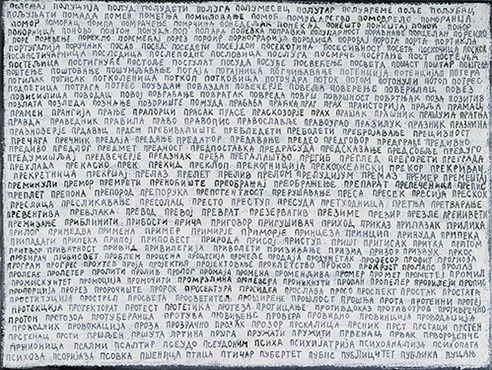
Dragana Radivojević, 904 Words Starting With P, oil, pigment and wax on canvas, 2006.
Dragana Radivojević’s project Intermezzo is a series of objects created and presented in the domain of visual arts. Their pseudo-lexicographic look relativizes the prevailing concept of reading in the art theory whose language-based platform limits the non-verbal values of inventiveness and implicates some kind of poltroon servility. In Intermezzo, the syncopated recitation is a complex tool for the artist’s self-reflection that, through interrelationship of perception, conceptualization and hermeneutics, tends to dominate the mental space of the observer, simultaneously supporting the observer’s impulse to compromise that very self-reflection through ‘insight’ and ‘understanding’. That tension is evident in the material quality of the objects whose carefully impregnated, prepared and painterly balanced skin-fetish regresses into language by the artist’s persistent scratching-scribbling-registering.
Hybridizing its visual elegance, which illustrates how superior contemporary painting can be, with highly emotional energy of the transmutational chant in which every image-term emanates from the previous one, Intermezzo gives a discreet homage to a mesmerisingly hermetic but almost forgotten opus of Stevan Knežević who was Dragana Radivojević’s mentor. This dedication, further supported by certain restraint in the gallery presentation of the project, also implies that art is never taken seriously in a broader social context except, of course, as a networked system for the flow of capital. This cynicism is no longer personal, but it is the cynicism of the current situation in which the artist’s position becomes boring and rather bleak since art, as a specific, skillful mode of organizing free time, transforms into a set of businesses. In the routine of culturally induced art production, with the consequent recession of intelligent critique or provocation, the inflation of ‘signs’, ‘terms’ and their ‘meanings’ discredits not only the discourse but the very events that, although they still happen, mostly have no consequences.
Intermezzo was created in an ambivalent range between the explicit articulation of this problem and the ephemeral silence of micro-narrative as one of the legitimate options in today’s authorial pluralism in which the space for the relevant creativity shifts towards the field of thought – abstract and opaque, alien and discerning. In Duchamp’s time, it was the artistic concept, today it is the reality, and Intermezzo is the text that is not it.
Politika, Culture - Art - Science No. 33/LI, 27 November, p. 06, Belgrade, 2007.